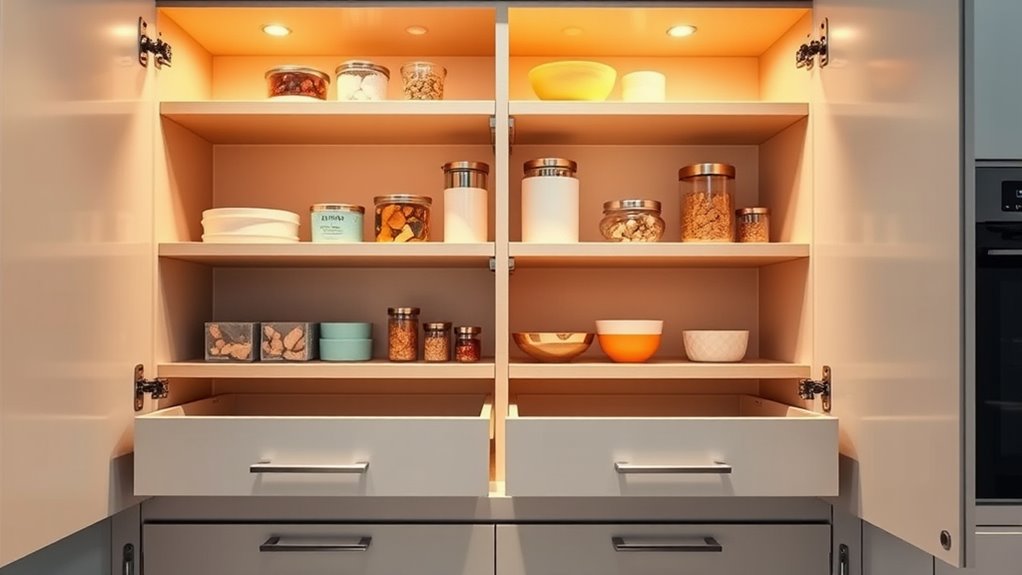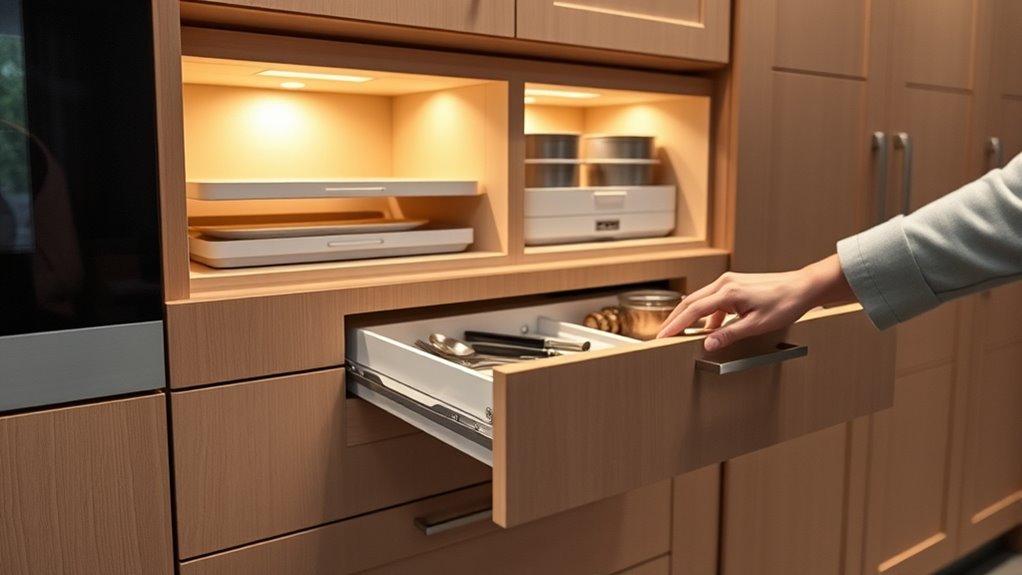Designing cabinets for comfort and accessibility means incorporating adjustable shelves and ergonomic handles that suit your needs. With customizable interior layouts, you can easily fit items at ideal heights, reducing bending or stretching. Ergonomic handles make opening and closing effortless, preventing strain on your shoulders and back. These features promote better organization and maximize efficiency. If you want to discover additional tips for creating a workspace that supports your comfort, keep exploring the options available.
Key Takeaways
- Incorporate adjustable shelves to customize storage height and reduce bending or stretching during access.
- Use ergonomic handles that are easy to grip, reducing effort and shoulder strain when opening cabinets.
- Design cabinet placement at natural reach zones to minimize awkward movements and improve accessibility.
- Ensure clear organization with adjustable features to facilitate quick item retrieval and reduce workspace clutter.
- Prioritize user-centered design elements that promote comfort, safety, and efficient workflows in cabinet use.

Cabinet ergonomics focuses on designing storage solutions that make your workspace more comfortable and efficient. When you pay attention to how cabinets are arranged and built, you reduce strain and improve accessibility. One key feature to consider is adjustable shelving. With adjustable shelves, you can customize the interior layout to fit your specific needs, whether you’re storing tools, office supplies, or kitchen essentials. Instead of struggling to reach or bend awkwardly, you can simply move shelves to the most convenient height. This flexibility minimizes unnecessary stretching or bending, which can cause discomfort over time. It also helps you maintain an organized space, as items are easier to access when stored at ideal heights. Additionally, incorporating smart storage solutions can further optimize your cabinet layout for ease and convenience.
Alongside adjustable shelving, ergonomic handles play an essential role in cabinet comfort. Traditional handles might force you to grip tightly or twist awkwardly, especially if they’re small or poorly positioned. Ergonomic handles are designed to fit comfortably in your hand, reducing the effort needed to open and close cabinets. They often feature larger, textured surfaces or softer grips, making them easier to grasp even if you have limited hand strength or dexterity issues. Installing ergonomic handles at a height that suits your natural reach ensures you don’t strain your shoulders or back when accessing stored items. These handles also help promote better posture because you don’t have to lean or stretch excessively to open cabinets.
When you combine adjustable shelving with ergonomic handles, you’re creating a workspace that truly adapts to your needs. You can position shelves at comfortable heights, eliminating the need for awkward stretching or bending. Ergonomic handles make opening cabinets effortless, encouraging regular organization and quick access. This combination reduces fatigue during your workday and minimizes the risk of repetitive strain injuries. Plus, it makes your entire workspace more intuitive—everything is within easy reach, and every movement feels natural. Over time, these small ergonomic improvements add up, making your environment safer and more pleasant to work in.
Ultimately, paying attention to these details—adjustable shelving and ergonomic handles—demonstrates a thoughtful approach to cabinet design. It’s about prioritizing your comfort, reducing physical stress, and improving overall efficiency. When your storage solutions are tailored to your body’s needs, you’ll notice less fatigue and more ease in your daily routines. Whether you’re outfitting a kitchen, workshop, or office, implementing ergonomic principles in cabinet design empowers you to work smarter, not harder, and makes your space a more enjoyable place to be.
Frequently Asked Questions
How Do I Measure My Cabinet Space Accurately?
To measure your cabinet space accurately, start with measurement techniques like using a tape measure or ruler to record height, width, and depth. Be sure to measure from wall to wall and include any protrusions or obstructions. For effective space planning, double-check your measurements and note down exact dimensions. This guarantees your cabinets fit well and are accessible, making your design both functional and comfortable.
What Materials Are Best for Ergonomic Cabinet Design?
Imagine your ideal kitchen, where every handle feels just right. For ergonomic cabinet design, opt for materials with high durability like solid wood or steel, ensuring longevity through daily use. Choose options with aesthetic versatility, such as sleek laminate or natural wood finishes, to match your style. These materials not only stand up to wear but also enhance your space’s look, making your cabinets both functional and beautiful for years to come.
Can Ergonomic Cabinets Be Customized for Small Kitchens?
Yes, ergonomic cabinets can be personalized for small kitchens. You can explore custom cabinet options that maximize space, such as taller cabinets, pull-out shelves, and corner solutions. These small kitchen solutions improve accessibility and comfort by reducing the need to stretch or bend. By tailoring the design to your space, you assure everything is within easy reach, making your kitchen more functional and comfortable to work in.
How Do I Ensure Safety in Ergonomic Cabinet Installation?
Imagine opening a cabinet that feels like it’s part of your home, safe and stable. To guarantee ergonomic safety, anchor all cabinets securely to the wall and check for smooth operation. Avoid overloading shelves, and make sure cabinet doors open easily without wobbling, ensuring cabinet stability. Regularly inspect hardware for wear, and follow manufacturer instructions carefully. These steps keep your ergonomic cabinets safe, stable, and perfect for everyday use.
What Maintenance Is Required for Ergonomic Cabinet Features?
To keep your ergonomic cabinets in top shape, regularly clean the cabinet surfaces to prevent dust buildup and guarantee smooth operation. You should also lubricate hinges periodically to maintain effortless access and prevent squeaking. Check for loose hardware or misaligned parts and tighten or adjust as needed. Consistent maintenance like cleaning and hinge lubrication helps preserve the cabinet’s functionality, extends its lifespan, and keeps it safe and comfortable to use.
Conclusion
So, after all this talk about creating the perfect cabinet, you might think comfort and accessibility are just fancy extras. But in reality, neglecting ergonomic design can turn everyday tasks into frustrating battles. Ironically, what should be simple often becomes complicated when you ignore these principles. So go ahead, prioritize ergonomics—you might just save yourself from unnecessary strain and headaches, proving that sometimes, the most obvious choices are the ones we overlook.








